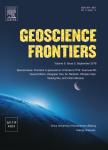The second continent:Existence of granitic continental materials around the bottom of the mantle transition zone
The second continent:Existence of granitic continental materials around the bottom of the mantle transition zone作者机构:Department of Earth ScienceUniversity of CaliforniaSanta BarbaraCA 93106USA Department of Earth and Planetary SciencesTokyo Institute of TechnologyOokayama 2-12-1MeguroTokyo 152-8551Japan Department of Earth and Planetary SciencesTokyo Institute of TechnologyOokayama 2-12-1MeguroTokyo 152-8551.Japan Department of Earth Science and AstronomyGraduate School of Arts and SciencesThe University of TokyoKomaba 3-8-1MeguroTokyo 153-8902Japan Geodynamics Research CenterEhime University.Bunkyo-cho 2-5MatsuyamaEhime 790-8577Japan
出 版 物:《Geoscience Frontiers》 (地学前缘(英文版))
年 卷 期:2013年第4卷第1期
页 面:1-6页
核心收录:
学科分类:070902[理学-地球化学] 0709[理学-地质学] 07[理学] 0708[理学-地球物理学] 0704[理学-天文学]
基 金:the support of a JSPS Fellowship for Young Scientists to K.K the Grant-in-Aid for Scientific Research from JSPS(Grant No.20001005) to T.T and the Grant-in-Aid for Scientific Research from JSPS(Grant No. 20244083) to S.M
主 题:Continental growthGraniteFirst principlesMantle transition zoneTectonicsGeodynamics
摘 要:It has been thought that granitic crust, having been formed on the surface, must have survived through the Earth's evolution because of its buoyancy. At subduction zones continental crust is predominantly created by arc magmatism and is returned to the mantle via sediment subduction, subduction erosion, and continental subduction. Granitic rocks, the major constituent of the continental crust, are lighter than the mantle at depths shallower than 270 km, but we show here, based on first principles calcu- lations, that beneath 270 km they have negative buoyancy compared to the surrounding material in the upper mantle and transition zone, and thus can be subducted in the depth range of 270-660 km. This suggests that there can be two reservoirs of granitic material in the Earth, one on the surface and the other at the base of the mantle transition zone (MTZ). The accumulated volume of subducted granitic material at the base of the MTZ might amount to about six times the present volume of the continental crust. Our calculations also show that the seismic velocities of granitic material in the depth range from 270 to 660 km are faster than those of the surrounding mantle. This could explain the anomalous seismic-wave velocities observed around 660 km depth. The observed seismic scatterers and reported splitting of the 660 km discontinuity could be due to jadeite dissociation, chemical discontinuities between granitic material and the surrounding mantle, or a combination thereof.



